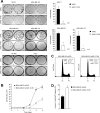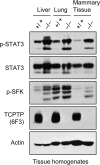TCPTP regulates SFK and STAT3 signaling and is lost in triple-negative breast cancers
- PMID: 23166300
- PMCID: PMC3554209
- DOI: 10.1128/MCB.01016-12
TCPTP regulates SFK and STAT3 signaling and is lost in triple-negative breast cancers
Erratum in
-
Correction.Mol Cell Biol. 2023;43(11):629. doi: 10.1080/10985549.2023.2277100. Epub 2023 Nov 17. Mol Cell Biol. 2023. PMID: 37955527 Free PMC article. No abstract available.
Abstract
Tyrosine phosphorylation-dependent signaling, as mediated by members of the epidermal growth factor receptor (EGFR) family (ErbB1 to -4) of protein tyrosine kinases (PTKs), Src family PTKs (SFKs), and cytokines such as interleukin-6 (IL-6) that signal via signal transducer and activator of transcription 3 (STAT3), is critical to the development and progression of many human breast cancers. EGFR, SFKs, and STAT3 can serve as substrates for the protein tyrosine phosphatase TCPTP (PTPN2). Here we report that TCPTP protein levels are decreased in a subset of breast cancer cell lines in vitro and that TCPTP protein is absent in a large proportion of "triple-negative" primary human breast cancers. Homozygous TCPTP deficiency in murine mammary fat pads in vivo is associated with elevated SFK and STAT3 signaling, whereas TCPTP deficiency in human breast cancer cell lines enhances SFK and STAT3 signaling. On the other hand, TCPTP reconstitution in human breast cancer cell lines severely impaired cell proliferation and suppressed anchorage-independent growth in vitro and xenograft growth in vivo. These studies establish TCPTP's potential to serve as a tumor suppressor in human breast cancer.
Figures









Comment in
-
On the role of tyrosine phosphatases as negative regulators of STAT signaling in breast cancers: new findings and future perspectives.Breast Cancer Res. 2013 Jul 31;15(4):312. doi: 10.1186/bcr3437. Breast Cancer Res. 2013. PMID: 23905670 Free PMC article.
Similar articles
-
Cell cycle-dependent regulation of SFK, JAK1 and STAT3 signalling by the protein tyrosine phosphatase TCPTP.Cell Cycle. 2008 Nov 1;7(21):3405-16. doi: 10.4161/cc.7.21.6950. Epub 2008 Nov 8. Cell Cycle. 2008. PMID: 18948751
-
Long non-coding RNA TINCR promotes hepatocellular carcinoma proliferation and invasion via STAT3 signaling by direct interacting with T-cell protein tyrosine phosphatase (TCPTP).Bioengineered. 2021 Dec;12(1):2119-2131. doi: 10.1080/21655979.2021.1930336. Bioengineered. 2021. PMID: 34057016 Free PMC article.
-
T-cell protein tyrosine phosphatase attenuates STAT3 and insulin signaling in the liver to regulate gluconeogenesis.Diabetes. 2010 Aug;59(8):1906-14. doi: 10.2337/db09-1365. Epub 2010 May 18. Diabetes. 2010. PMID: 20484139 Free PMC article.
-
The Multifaceted Role of STAT3 in Mammary Gland Involution and Breast Cancer.Int J Mol Sci. 2018 Jun 7;19(6):1695. doi: 10.3390/ijms19061695. Int J Mol Sci. 2018. PMID: 29875329 Free PMC article. Review.
-
The role of T-cell protein tyrosine phosphatase in epithelial carcinogenesis.Mol Carcinog. 2019 Sep;58(9):1640-1647. doi: 10.1002/mc.23078. Epub 2019 Jul 1. Mol Carcinog. 2019. PMID: 31264291 Free PMC article. Review.
Cited by
-
STAT3 as a potential therapeutic target in triple negative breast cancer: a systematic review.J Exp Clin Cancer Res. 2019 May 14;38(1):195. doi: 10.1186/s13046-019-1206-z. J Exp Clin Cancer Res. 2019. PMID: 31088482 Free PMC article.
-
Regulation of platelet-activating factor-mediated interleukin-6 promoter activation by the 48 kDa but not the 45 kDa isoform of protein tyrosine phosphatase non-receptor type 2.Cell Biosci. 2019 Jun 25;9:51. doi: 10.1186/s13578-019-0316-9. eCollection 2019. Cell Biosci. 2019. PMID: 31289638 Free PMC article.
-
The pseudokinase SgK223 promotes invasion of pancreatic ductal epithelial cells through JAK1/Stat3 signaling.Mol Cancer. 2015 Jul 29;14:139. doi: 10.1186/s12943-015-0412-3. Mol Cancer. 2015. PMID: 26215634 Free PMC article.
-
PTPN2 Inhibition Disrupts Mitochondrial Renewal and Blocks TFRC-Mediated Mitophagy to Exert Anti-Tumor Activities in ALK-Positive Anaplastic Large Cell Lymphoma.Adv Sci (Weinh). 2025 Aug;12(31):e14282. doi: 10.1002/advs.202414282. Epub 2025 Jul 30. Adv Sci (Weinh). 2025. PMID: 40734623 Free PMC article.
-
The protein tyrosine phosphatase DEP-1/PTPRJ promotes breast cancer cell invasion and metastasis.Oncogene. 2015 Oct 29;34(44):5536-47. doi: 10.1038/onc.2015.9. Epub 2015 Mar 16. Oncogene. 2015. PMID: 25772245
References
-
- Yarden Y. 2001. Biology of HER2 and its importance in breast cancer. Oncology 61(Suppl 2):1–13 - PubMed
-
- Nielsen TO, Hsu FD, Jensen K, Cheang M, Karaca G, Hu Z, Hernandez-Boussard T, Livasy C, Cowan D, Dressler L, Akslen LA, Ragaz J, Gown AM, Gilks CB, van de Rijn M, Perou CM. 2004. Immunohistochemical and clinical characterization of the basal-like subtype of invasive breast carcinoma. Clin. Cancer Res. 10:5367–5374 - PubMed
-
- Biscardi JS, Belsches AP, Parsons SJ. 1998. Characterization of human epidermal growth factor receptor and c-Src interactions in human breast tumor cells. Mol. Carcinog. 21:261–272 - PubMed
Publication types
MeSH terms
Substances
LinkOut - more resources
Full Text Sources
Other Literature Sources
Medical
Molecular Biology Databases
Research Materials
Miscellaneous
